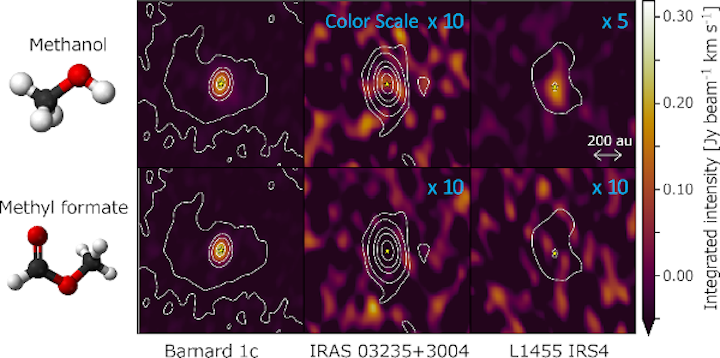12.04.2021

Distribution of molecular gas around the protostars. Color shows intensities of molecular emission, while contours show the thermal emission from dust. The existence of organic molecules appears to be irrelevant to the total amount of material.
An international group of scientists led by the RIKEN Cluster for Pioneering Research have studied the chemical composition of 50 protoplanetary-disk forming regions in the Perseus Molecular Cloud, and found that despite being in the same cloud, the amounts of complex organic molecules they contain are quite different. Interestingly, the chemically rich young disks have similar compositions of organic molecules. These findings raise an important question: do solar-like systems share a common chemistry at birth?
Giant radio pulses—a phenomenon where extremely short, millisecond-duration pulses of radio waves are emitted—have been observed in association with a dozen pulsars in our Galaxy, but little is known about the mechanism that causes them. It has been proposed that they may also be the origin of “fast radio bursts”—rapid bursts of radio waves that are believed to originate from energetic events in the extragalactic universe.
It was once believed that complex organic molecules were rare in the universe, and that this rarity might be a reason we have not found evidence of life outside the earth. However, in the last two decades it has become clear that these molecules are common. According to Yao-Lun Yang, who led the research as a member of the Star and Planet Formation Laboratory in the RIKEN Cluster for Pioneering Research, and is now at the University of Virginia as a VICO Origins postdoctoral fellow, “Today, scientists have begun to systematically survey protoplanetary disks—disks where planets eventually form around a star—in the hope of determining how these molecules form, how common they are, and what impact they have on planetary systems.”
Though scientists have looked at individual systems, there is little comparative data to understand these young stars as a group. The RIKEN-led group decided to use observations from the ALMA observatory in Chile, which thanks to its high resolution allows scientists to study chemical compounds in protoplanetary disks. The observations required more than three years to complete.
The group surveyed the emission from organic molecules at specific frequencies in very young disks. They looked at methanol and acetonitrile, as well as two larger molecules, methyl formate and dimethyl ether. They found that different regions had large variation in the abundance of methanol and acetonitrile, though intriguingly, the relative abundance between the two species was remarkably similar. According to Yang, “This implies that there is a common production mechanism of these two molecules, and this give us important hints on how they form in space.” In addition, the abundances of methyl formate and dimethyl ether tended to be higher relative to methanol in denser regions, hinting that there is something about the denser conditions that allows them to be abundant. Their findings were published by the American Astronomical Society last week in The Astrophysical Journal.
According to Nami Sakai, leader of the Star and Planet Formation Laboratory, “This raises important questions regarding how special the chemical environment of the infant Solar system is. We will be able to answer this question in the future by examining the chemical evolution of the gas surrounding young protostars. We hope that such knowledge will be a base for understanding the origin of life on the Earth.
Quelle: RIKEN
